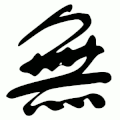無
- to not have, none, nothing;
Etymology
Original meaning: to dance.
In oracle bone script (甲骨文), the character showed a person (大 shape) standing with long ornamental tassels hanging down — depicting a ritual dance.
As time passed, this character was borrowed phonetically to mean “none” / “not have”.
To distinguish the original meaning “dance,” the component 舛 (misstep) was added, forming 舞 (dance).
Later, in seal script (篆書), scribes added 亾 (亡 “to perish”) to reinforce the “not have” meaning.
The bottom 灬 in the modern form 無 looks like “fire,” but it’s not originally related to fire — it’s simply a cursive simplification from earlier scripts.
Usage in Korean
In Classical Chinese and literary contexts, 無 is widely used for “not” or “none.”
In modern spoken Mandarin, the phrase 没有 (méiyǒu) is used instead for “don’t have,” while 無 (无) remains in compounds or formal/literary style.
In Japanese, read as mu or bu (in compounds), meaning “nothingness” — a key concept in Zen (e.g., 無心 “no-mind”, 無我 “selflessness”).
In Korean, it is read 무 and widely used in compounds like 무한(無限, infinite), 무죄(無罪, innocent).
Words that derived from 無
- 무관(無官)–being uncrowned
- 무궁화(無窮花)–hibiscus syriacus
- 무리(無理)–being too much; unreasonableness; impracticality; being out of reach; burden; stress; strain
- 무명(無名)–being unknown; being nameless; being anonymous; namelessness; obscurity
- 무시(無視)–disregard; neglect
- 무시하다(無視하다)–disregard; neglect
- 무자비(無慈悲)–mercilessness; cruelty
- 무전기(無電機)–radio
- 무제(無題)–untitled
- 무제한(無制限)–being unlimited
- 무지(無知)–ignorance; stupidity
- 무질서(無秩序)–disorder
- 무형(無形)–intangibility; formlessness
- 유무(有無)–existence and nonexistence
Alternative forms
无, 橆
- 人廿火 (OTF)
- ⿱⿳ 𠂉 卌 一 灬
